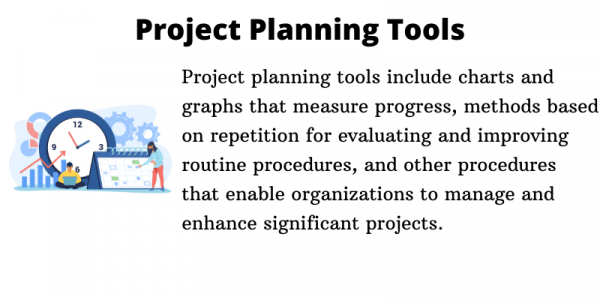Having natural and acquired skills is crucial for the success of every project manager. However, with the increasing complexities of projects, it has become challenging to manage them without project planning techniques.
One way or another, these techniques give you an edge over other project managers and help you create a detailed plan, track progress, and keep everyone aligned on the project’s status. Simply put, these tools play a significant role in your project’s success.
- Importance of Project Planning Techniques
- List of the Best Project Planning Techniques
- 1. Gantt Chart
- 2. Critical Path Method (CPM)
- 3. Waterfall
- 4. Program Evaluation and Review Technique (PERT)
- 5. Work Breakdown Structure (WBS)
- 6. Kanban
- 7. Scrum
- 8. Extreme Programming (XP)
- 9. Agile
- 10. Scaled Agile Framework (SAFe)
- 11. Adaptive Project Framework (APF)
- 12. Critical Chain
- 13. Rational unified process (RUP)
- 14. Event chain methodology
- 15. Projects IN Controlled Environments (PRINCE2)
- Tips for Successful Project Plan Execution
But with many project planning examples and techniques available in the market, choosing the right one takes time and effort. To help you out, we have compiled a list of the 15 best project planning techniques currently ruling the roost.
Importance of Project Planning Techniques
Improves team communication and collaboration
Through project planning techniques, you can create a central place where everyone can access the latest project status. The techniques play a big role in keeping team members in the loop about even the smallest project planning steps and details.
Projects are composed of members from different departments who need to do their tasks, so it’s tough for some of them to frequently go to meetings and stay informed. This communication gap can result in unnecessary project delays, costing a lot of time and money.

Better resource management
Successful project management is about more than just allocating the right resources to tasks but also making sure that these resources are utilized efficiently. Project planning techniques give you a clear overview of the skills and availability of your team members.
This information is handy when you’re trying to assign tasks and avoid over-allocation or over/over-staffing your project teams. Moreover, these techniques make it easier to track resource utilization and calculate the cost of each project. This way, you can optimize your resources and ensure that your projects are completed within budget.
Efficient task management
With the help of project planning techniques, you can create task lists, set deadlines, and monitor progress to ensure that you can finish activities on time. Moreover, you can also add files and comments to each task to provide more clarity.
In addition, some project management techniques allow you to create dependency chains which help you visualize the sequence in which tasks you need to complete. This way, you can avoid any bottlenecks and keep your project on track.

Accurate reporting and analytics
Project management techniques make it easier to generate accurate reports. With just a few clicks, you can generate reports on the progress of your project, budget, and resources. This information comes in handy when you’re trying to present the status of your project to stakeholders.
These techniques also offer valuable insights and help you identify any potential risks. This way, you can nip them in the bud before they can negatively impact your project.

Identifies and mitigates risk
No project is free of risks. However, proper risk management can help you avoid any potential problems to ensure your project’s success.
Using the techniques and following your project planning process diagram, you can identify risks and take preventive measures to mitigate them. In addition, these tools also offer valuable insights that can help you avoid potential risks in the future.

Increases productivity
Project management techniques help you automate repetitive tasks so you can focus on more important things. For instance, you can set up automatic alerts and notifications to keep everyone in the loop.
In addition, these techniques also offer features like task dependencies and templates, which help you save a lot of time. This way, you can increase your team’s productivity and complete your project within the set timeframe.
List of the Best Project Planning Techniques
1. Gantt Chart
A Gantt chart is a bar graph with a horizontal orientation that displays a project’s planned schedule, including its task events, from start to finish date. It clearly and concisely shows activities against a timeline.
This project planning tool helps keep everyone on the team organized and up-to-date on deadlines, milestones, and project progress. Gantt charts have three main components:
- date/time (duration of each task)
- items/tasks (activities)
- the owner (person responsible for a task)
2. Critical Path Method (CPM)
CPM is a helpful tool for anyone who needs to calculate how long a project will take. It is recommended for projects with many different aspects because it helps avoid any issues or delays along the way.
You can calculate a more accurate timeline for the project by determining which tasks need to be completed before other teams start their assigned tasks. It also lets you estimate how long the project will take.
3. Waterfall
It is one of the most basic projects management techniques and focuses on ensuring that the planning and execution phases are carried out effectively.
Because Waterfall is sequential, you should finish each task before starting something new. With this approach, the individual execution teams typically work independently until they need to do integration.
4. Program Evaluation and Review Technique (PERT)
PERT is a project management tool that not only calculates the estimated time to complete a project but also aids in efficient scheduling and budgeting.
It helps team members better coordinate their work and meet deadlines. This tool optimizes the accuracy of task duration predictions by using three different inputs for its calculation: optimistic, most probable, and pessimistic.
5. Work Breakdown Structure (WBS)
WBS project management tool helps break the tasks into smaller, more manageable pieces. By breaking down projects into smaller pieces, teams can see which tasks depend on others and when they need to be completed.
Its primary purpose is to map out the project’s timeline. The duration of each task is planned following any prerequisite tasks and subsequent tasks. The WBS then provides a detailed plan to help you understand how the project should develop.
6. Kanban
Kanban is a visual tool that helps you plan and organize work items into development columns. This tool allows you to see your project clearly and measure your progress. If you’re a first-time project manager, this is one of the easiest project management techniques for you.
Kanban is recommended for simpler projects or teams prone to multitasking. It simply revolves around three columns: To-do, Doing, and Done. As you complete tasks, move them across the columns so that others know the current status of each project.
7. Scrum
This flexible project-planning tool relies on iterative processes, adjustments, and continuous learning. Project progress is regularly monitored by measuring the sequence of short, time-sensitive periods called sprints. The end of every sprint signifies completing one planned amount of work.
Scrum allows teams to communicate, work together efficiently, and develop projects quickly by focusing on the client’s most pressing priorities and requirements.
8. Extreme Programming (XP)
Extreme programming is a collaborative planning tool that encourages teamwork and decomposes complex projects into multiple smaller releases. It is designed to help the team work quickly and efficiently through a set of values rather than just being a means to manage projects.
Even though XP’s structure may seem rigid, the end product is usually much higher quality because of the short sprints and continuous integrations.
9. Agile
This planning tool employs the ‘sprint approach’ to segment a project into more manageable portions. It is characterized by being able to adapt and change as needed rapidly.
Agile allows for greater flexibility and collaboration between team members. It is mostly used by software developers and is suitable for small projects requiring constant communication among project members.
10. Scaled Agile Framework (SAFe)
It implements agile planning at scale. SAFe’s agile practices offer a guide for teams to build improved products by being responsive to changes in market conditions, customer requirements, and innovations.
SAFe enables companies to make quicker decisions, communicate more efficiently, optimize operations, and maintain customer focus by promoting team collaboration and increasing productivity.
11. Adaptive Project Framework (APF)
APF is based on the belief that you must make changes immediately after a problem occurs. It teaches the team to set up systems with a backup plan so that the project will still run smoothly if something falls through.
The tool helps to implement changes faster and to adapt the plan as soon as a roadblock is identified. In APF, the client always has the final say. Without the client’s approval, we cannot move forward. The client is in complete control of where the project goes next.
12. Critical Chain
Task dependency is vital in this project planning tool. It views a project as starting from an initial task or date, branching out, and ending when all tasks are complete. Each task affects the ones that come before and after it.
The critical chain method is helpful in planning and allocating resources for a project. It minimizes any chances that later on in the process, you will be delayed waiting for resources. In addition, it is excellent for risk management because you can only advance along the critical path after confirming that you have all the necessary resources.
13. Rational unified process (RUP)
This project planning tool is most effective in trial-and-error projects, where each new try produces an iteration for further testing and feedback. It allows for a more agile approach that can improve the chances of success.
RUP’s key focus is on making changes near the end of a project to better software performance and get a more precise measure of user experience.
14. Event chain methodology
The team can better identify manageable tasks through event chain methodology while understanding the relationships between these said events. It simplifies the process by implementing a risk management plan set by the project manager.
This tool helps manage tasks that could positively or negatively affect a project’s success. It helps ensure that every aspect of the project is well-managed and that deadlines and schedules are met.
15. Projects IN Controlled Environments (PRINCE2)
This project planning method is designed to help you manage risks and resources by breaking your project down into smaller stages. PRINCE2 requires a clear and controlled project plan before starting.
It hones in on specific areas of attention that are integral at every project stage to ensure that everything aligns with the business goal.
Tips for Successful Project Plan Execution
Define the scope of your project
The first step in any project is to define the scope. It includes setting goals and objectives and identifying what needs to be done. By having a clear scope, you can avoid problems later on.
Delegate tasks properly
Assign tasks to the right people based on their skills and knowledge. Make sure that everyone knows what is expected of them and that they have the resources they need to complete their assigned tasks.
Allow everyone on the team to make decisions
Empower team members to make decisions within their area of expertise. You can free up your time to focus on more important tasks by delegating authority.

Keep clear and open communication lines
Keep everyone in the loop by holding regular meetings and sending updates. It will help avoid misunderstandings and potential problems down the line.
Be flexible
You need to be able to adapt to changes. Be open to new ideas and willing to make changes to your plan if it means the project will be more successful.
Monitor progress regularly
Keep track of how your team is progressing by setting regular check-ins. This will help you identify potential problems early on and adjust the project plan as needed.
Use the right project-planning techniques
Various techniques and project planning templates are available, each with strengths and weaknesses. Choose the right tool for your project, and ensure everyone on the team knows how to use it.
There is no universal planning tool that will work for every project. Some techniques might not work for the type of project you are planning, so you should learn how to tailor your approach to the specific needs of your project.
Whatever kind of project you have, remember that the best planning tool is the one that will simplify your work and make it easier to monitor progress and make changes as needed.
